Positional Encoding from Sinusoidal to RoPE
 Jessen
JessenTable of contents

Transformers process the tokens of a text input in parallel, but unlike sequential models they do not understand position and see the input as a set of tokens. However when we calculate attention for a sentence, words that are the same but in different positions do receive different attention scores. If attention is a calculation between two embeddings, how can the same word i.e. same embedding, receive different scores when it is in a different position. It comes down to positional encoding, but before we get into how positional encoding works, lets run a test.
import torch
import torch.nn as nn
from transformers import AutoTokenizer, AutoModel
import matplotlib.pyplot as plt
import seaborn as sns
model_name = "bert-base-uncased"
# define sentence
sentence = "The brown dog chased the black dog"
#define tokenizer
tokenizer = AutoTokenizer.from_pretrained(model_name)
tokens = tokenizer(sentence, return_tensors="pt")["input_ids"]
# define token embeddings
model = AutoModel.from_pretrained(model_name)
token_embeddings = model.get_input_embeddings()(tokens)
embed_dim = token_embeddings.shape[-1]
class SimpleAttention(nn.Module):
def __init__(self, embed_dim):
super().__init__()
self.w_query = nn.Linear(embed_dim, embed_dim)
self.w_key = nn.Linear(embed_dim, embed_dim)
self.w_value = nn.Linear(embed_dim, embed_dim)
# Initialize weights
nn.init.normal_(self.w_query.weight, mean=0.0, std=0.8)
nn.init.normal_(self.w_key.weight, mean=0.0, std=0.8)
nn.init.normal_(self.w_value.weight, mean=0.0, std=0.8)
self.attention = nn.MultiheadAttention(embed_dim=embed_dim, num_heads=1, batch_first=True)
def forward(self, x):
output, attention_weights = self.attention(self.w_query(x), self.w_key(x), self.w_value(x))
return output, attention_weights
# Compute attention
attention_layer = SimpleAttention(embed_dim=embed_dim)
attention_output, attention_weights = attention_layer(token_embeddings)
# Convert attention weights to numpy array and remove extra dimensions
attention_matrix = attention_weights.squeeze().detach().numpy()
# Get token labels for the axes
tokens_text = tokenizer.convert_ids_to_tokens(tokens[0])
# Create heatmap
plt.figure(figsize=(10, 8))
sns.heatmap(attention_matrix,
xticklabels=tokens_text,
yticklabels=tokens_text,
cmap='YlOrRd',
annot=True,
fmt='.2f')
plt.title('Attention Weights Heatmap')
plt.xlabel('Key Tokens')
plt.ylabel('Query Tokens')
plt.tight_layout()
plt.show()
The code above will create a simple attention layer, without positional encoding. This enables our test to demonstrate how attention behaves when all tokens are treated purely based on their semantic embedding, without any positional differentiation. It has been initialised with random weights and has not undergone training, however training shouldn’t matter as tokens that are the same will have the same weights applied to them and result in the same output.
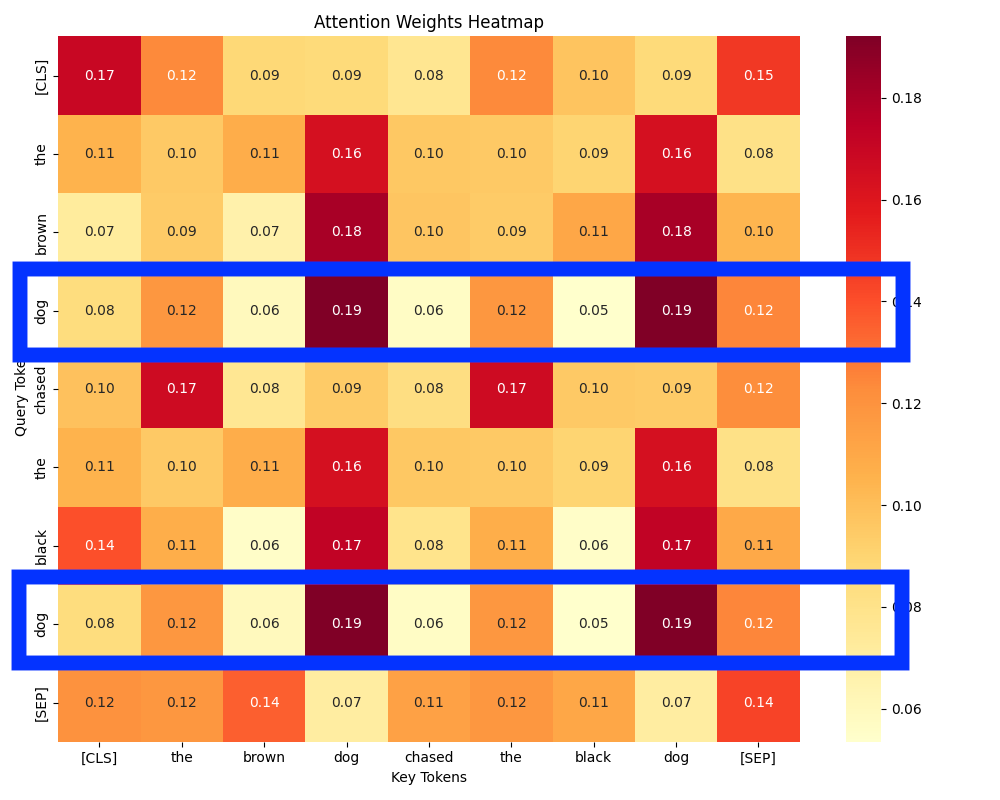
The attention heat map above is the output of our code. I’ve highlighted the use of two dog tokens to demonstrate how they receive equivalent attention weights against all other keys. For attention heads to be able to specialize e.g notice verb-object pairs, they must be able to differentiate between the same words in different positions otherwise they will receive the same result from the same weights being applied to token embedding.
What do positional encodings enable
In transformers we differentiate words at different positions with positional embeddings. This transformation perturbs the embedding based on the position of the word. For our example sentence in the code above, dog at position 3 would have a slightly different embedding to dog at position 7 after positional embeddings have been applied, resulting in a different attention result for each token. This will allow attention heads to see different positions and allow them to specialize e.g. an attention head that has specialized in recognising verb object pairs would have high attention with chases and the second dog, but not the first dog. However if each dog had not had their embedding slightly altered the specialized attention head could never notice that difference between both dogs.
Positional encodings step by step
Before we start to think about how positional encodings might be implements lets come up with some requirements
This is instead of passing in an addition feature meaning our neural network would have to interpret extra information and spend extra computation. By combining with existing embedding, we need a way for the network to see a different embedding when words are the same at different positions.
As shown early, each word needs to be uniquely identified even if the same word appears in a text sequence.
We want to create models that can generalise, therefore our positional encoding should be a pattern that can be recognised and accounted for in our attention matrices. We could assign random IDs to each position, and in theory this is learnable, however we would be using more learnable parameters than needed to account for the need to memorise individual IDs and the semantic information they contain for the various encounters. We are essentially forcing the transformer to memorise combinations of position and semantic information rather than allowing it to learn reusable patterns.
Add the position as an integer
An obvious thing to try to simply add the position of the token to the embedding. e.g. If dog was my first word and the embedding was [0.10, 0.80, 0.45], adding 1 to this would result in [1.10, 1.80, 1.45]. For the second word we would add 2 and so on.
However there are a few problems with this, first I could have many words in my input and say I reach the 100th word, adding 100 to each dimension of that token’s embedding will create very large numbers. In neural network we want to keep inputs on a similar scale to allow for faster convergence. However with our implementation embedding values will grow as we add more words to our input.
This requirement will ensure that embeddings stay within reasonable limits and do not grow too large. Another problem presented by our larger integers is the network will only be trained on the largest length it has seen, and therefore cannot generalise to any length. Ideally we want our network to work at lengths it has not seen.
Lastly the positional part of our embedding, seems to greatly outweigh the original embedding. It might be hard to see what the original input was, in fact it seems to completely change the embedding and more strong represent position than semantic information.
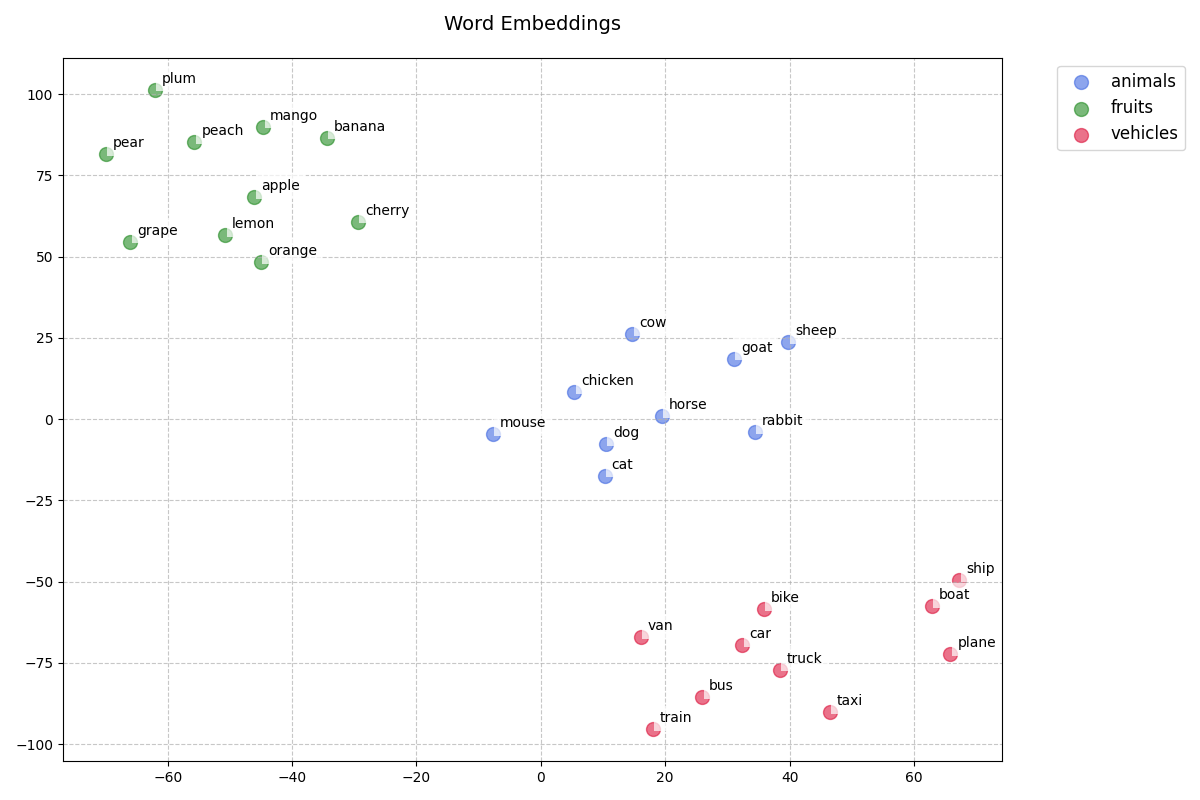
The graph above shows the embeddings of random list of words without positional information in reduced dimensional space. We can see clear semantic meaning, with words around the same concept clustering together.
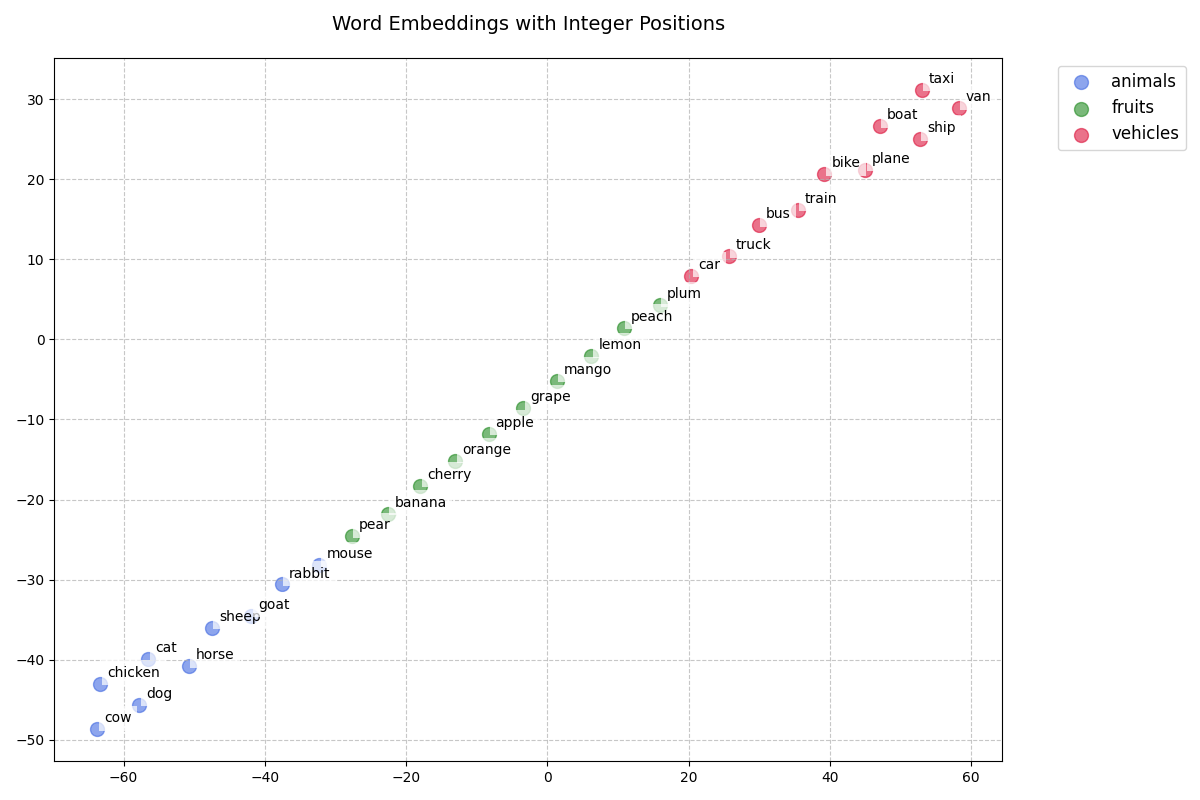
The graph above represents the same embeddings with integer positions added based on the position they were in the text sequence. We can see they no longer cluster as before and they seem to have a different semantic meaning. They also seem to be dominated by the some increasing order. Therefore adding a position with an integer is probably not going to work for us and has led us to a new requirement.
Sinusoidal Encoding
Based on our requirements so far, we’ve now come to the solution presented in the Attention Is All You Need paper. However let’s build up our understanding of how this works.
To help meet our requirements, let’s use a sine function, where the positional coding is sine(x), with x being our token position and the result added to our embedding element wise.
For example if our embedding was [0.1, 0.6, 0.8] our resulting embedding with positional information would be [0.1 + sin(0), 0.6 + sin(1), 0.2 + sin(2)].
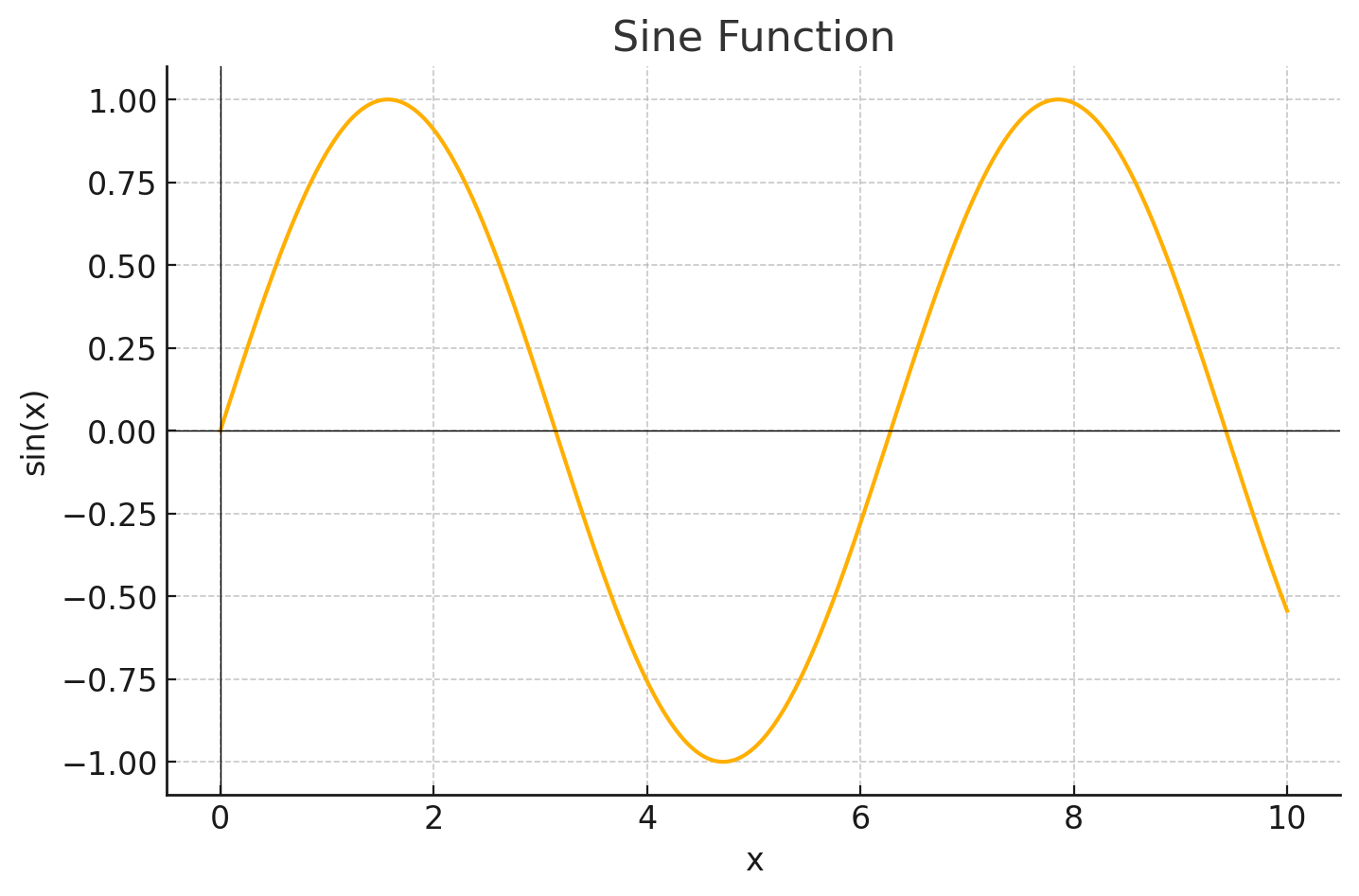
If we take the x axis to be our token position we can see that the numbers produced are small, helping to retain our embedding semantic information if added to each embedding element wise. Requirement wise it almost meets what we want, it can handle any sequence length as sine can be calculated for any x value, it is bounded between 1 and -1, it isn’t large enough to alter semantic information, however it most likely does not meet requirement 2: Positional Encodings must uniquely identify every word in a sequence.
As we can see sin(x) is periodic and it will eventually repeat itself for a tokens position. e.g sin(2) and sin(353) when rounded up will return the same value. This means for positions that return the same value, our attention mechanism will see them as the same position, and if they are the same word, we will have the same problem as not having positional encoding.
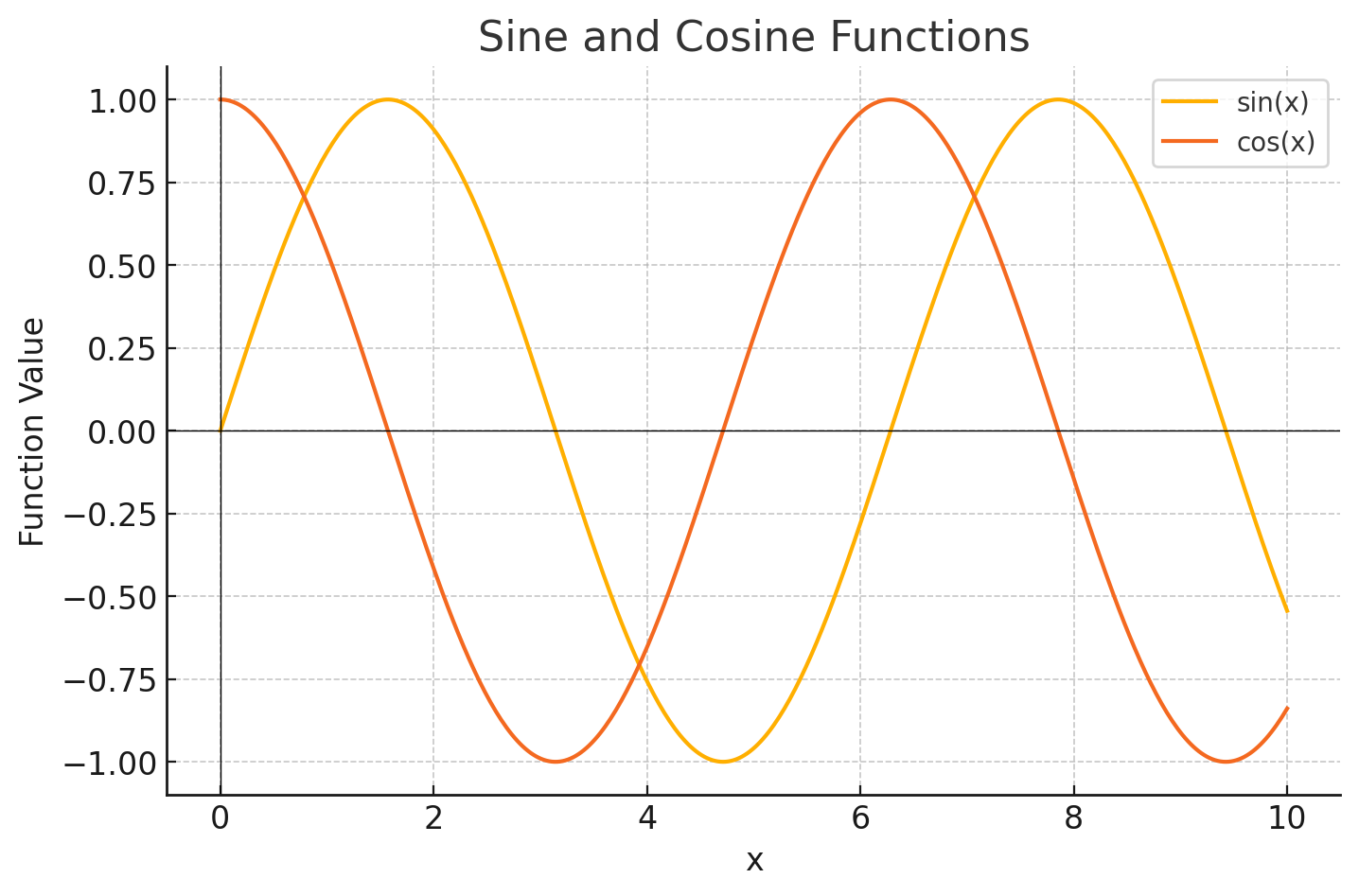
To help mitigate this we introduce cosine i.e. cos(x) as shown above and for each even index of our embedding we use sine and for odd indices we use cosine.
For example if our embedding was [0.1, 0.6, 0.8] our resulting embedding with positional information would be [0.1 + sin(0), 0.6 + cos(1), 0.2 + sin(2)].
Using cosine introduces a phase shift and greatly reduces the likelihood of receiving the same value for a position later in the sequence and the phase shift greatly reduces the chance of values being near each other. However there is still a chance of repeating at longer sequences lengths, plus with the regular periodicity it is hard to build relative patterns across long distances. This means we might not be meeting requirement 3: We must be able to generalise over positional encoding patterns. With this shortwave frequency it will be hard to generalise long distance patterns.
We can improve on both generalising over long range patterns reducing the chance of results collapsing into the same position by introducing lower frequencies. ie. we can create a general function which is sin(x/i) for even positions and cos(x/i) for odd positions where i is the the index of our embedding.
For example if our embedding was [0.1, 0.6, 0.8, 0.9] our resulting embedding with positional information would be [0.1 + sin(1), 0.6 + cos(1/2), 0.2 + sin(2/3), 0.8 + cos(2/4)].
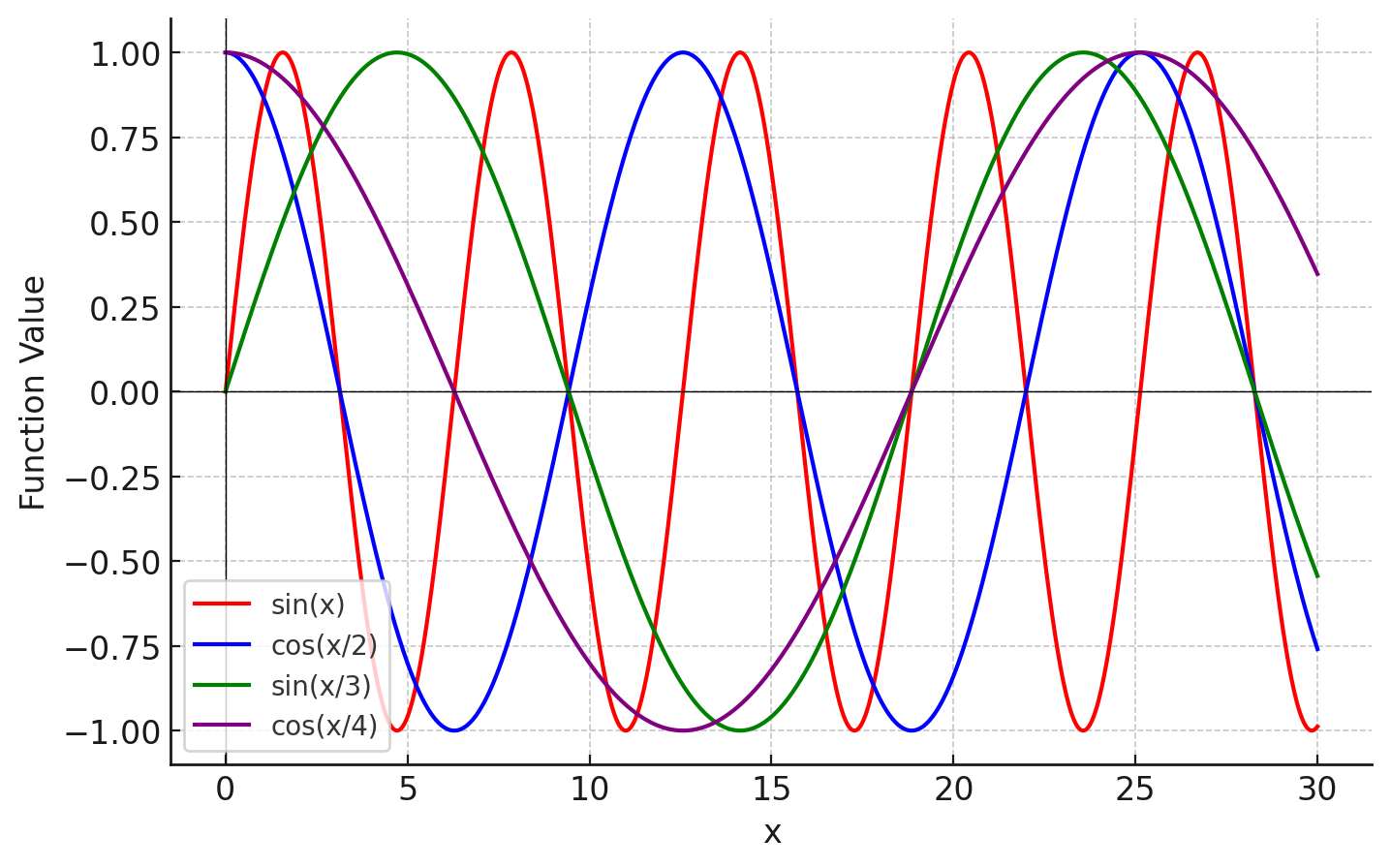
The graph has been expanded on the x axis compared to previous graphs, to show how dividing by the i-th position decreases the frequency. We would do this for all the dimensions of the embedding, therefore if our embeddings size was 768, we would have 768 individual values, where the frequency decreases as we move closer to the end of the embedding.
The decreased frequency can be used to generalise over long distances and the extra dimensions highlight short, medium and long distances allows our attention matrices to learn parameters that discard certain ranges and focus on what it needs for a particular attention head.
With our current solution, as we are only scaling up each embedding index linearly by increasing i, we could have many dimensions that don’t convey enough different information and therefore have redundant positional information.
Our current formulas are:
$$PE(pos, 2i) = \sin\left(\frac{pos}{2i}\right)$$
$$PE(pos, 2i+1) = \cos\left(\frac{pos}{2i}\right)$$
Above PE represents our positional encoding function, pos the token we are taking in, and i our embedding index.
In the Attention Is All You Need paper, the formulas used are
$$PE(pos, 2i) = \sin\left(\frac{pos}{10000^{2i/d}}\right)$$
$$PE(pos, 2i+1) = \cos\left(\frac{pos}{10000^{2i/d}}\right)$$
Here we can see rather than dividing by i, we have i as an exponent of 10000 and i is divided by d which represents the embedding size. This allows the the different dimensions to scale up logarithmically covering a wider range of frequencies rather than the previous linear scaling and also reduces redundant positional information. Using 10,000 as the base with an exponent is what allows the frequencies to scale up logarithmically, and d is used to control the scaling. Without d, it would scale far too quickly and might mean we miss important positional information. 10,000 was used as the base after experimenting in the Attention paper and provided a balance between scaling up and capturing enough information at different ranges. This great range of frequencies allows the model to generalise better, and gives more options for attention heads to focus on ranges for their specialisation.
Absolute vs Relative Positional Encoding
So we’ve built out positional encoding in the same way that was designed in the Attention Is All You Need paper and this method has been used in many models. However it has been improved upon and subsequently used in newer transformer models.
The problem with sinusoidal encoding is that is falls into a category known as absolute positional encoding. Absolute encoding adds a particular value or ID to each position, so position 1 receives a certain value, position 2 another etc. If I have the sentences “A man threw a ball” and another sentence “In the garden a man threw a ball”. In each sentence I have “man threw” in position 2, 3 and in position 5, 6 in the first and second sentence respectively. With sinusoidal encoding, man and threw will receive different positional encodings in each sentence. However in language, what creates meaning is less about absolute positions of related words but the relative position between them. If an attention head specialized in detecting subject and verb, it would have learn the value for man and threw differently for the two different sentences, by providing absolute values for each position, our learnt parameters have less chance to generalise, even though we do have some implicit relative positioning with sinusoidal encoding due to the periodicity introduced with sine and cosine waves. However the relative implicit relative positioning is hard to extract and models are not forced to look at this when absolute positioning is available.
With relative positioning, if we took the same sentence our encoding scheme would receive values that highlight the relative position between words, and not have absolute values. This forces the model to use relative values and also helps to generalise more, a property we want for our NLP models. For example in the case with man and threw in two sentences, our model could extract the fact the words are next to each, without having to memorise exact embedding plus positional values for different situations.
RoPE (Rotary Positional Embedding)
One way that has been used in many models to provide relative positional embeddings is RoPE.
Let’s imagine we have sentence 1 “The mouse ate some cheese” and sentence 2 “In the house a cat ate some cheese”
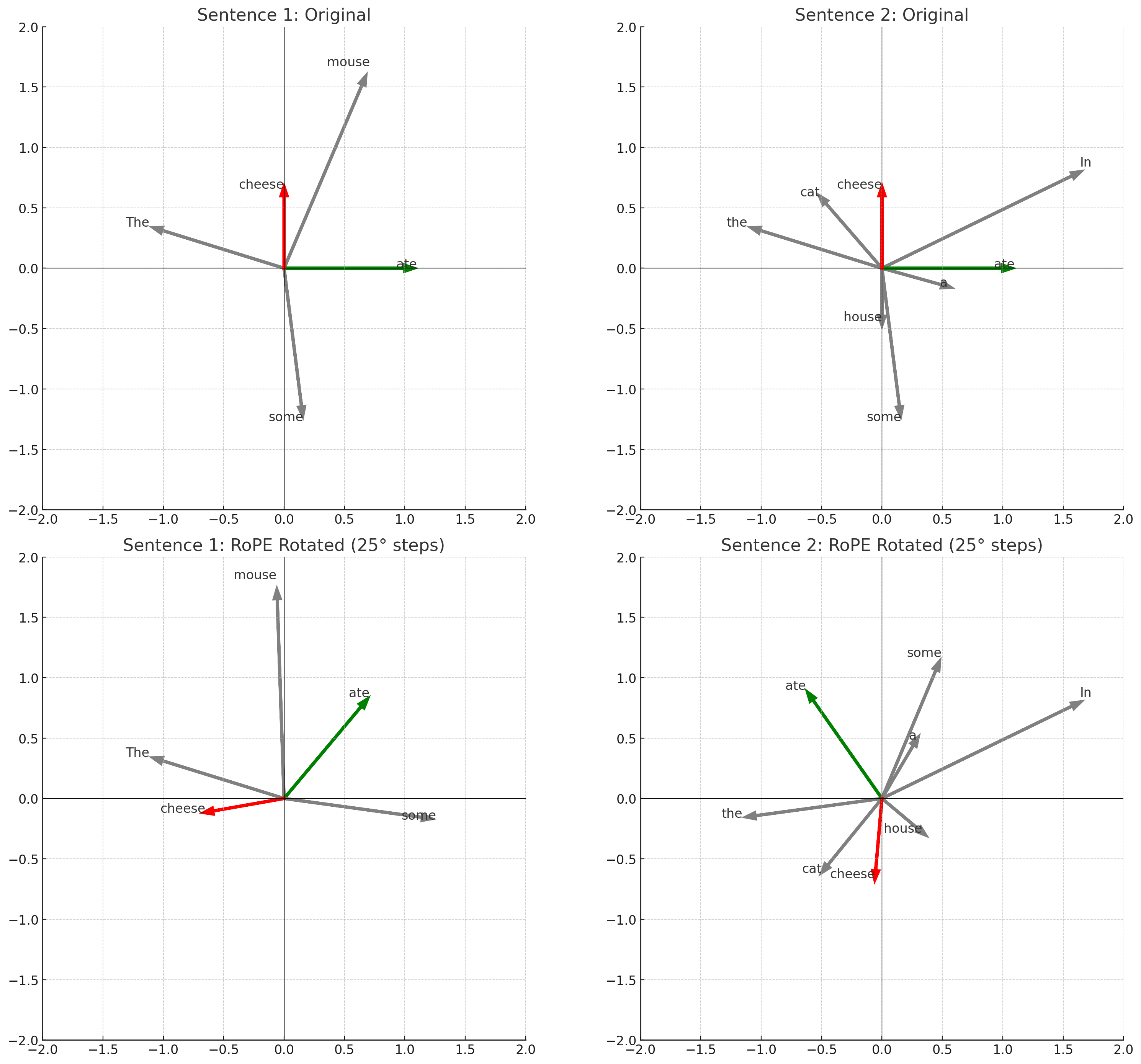
The graphs on the top represent simple 2D embedding for each word in our sentences. The graph below represents a rotation of each vector based on the their position using the transformation pθ where p is the word position and θ is 25° e.g. some in the first sentence at position 4 would be rotated by 4θ which is 100°. As we can see in the rotated embeddings, ate and cheese which have the same relative position in each sentence end up in different positions, due to their position, but the angle between them is the same as the relative distance is the same in each sentence. This is what RoPE does it takes an embedding, and rotates it by some θ based on it’s position.
RoPE and Attention Math
You can also see that every embedding has it’s magnitude maintained. No matter where we rotate the magnitude will be the same. We can see the importance of this by looking at how we calculate attention scores.
$$q⋅k=∥q∥∥k∥cos(θ)$$
We can see our attention scores rely on the norms of our vectors and angle between them. Since we have only rotated our vectors their norms stay the same, therefore any influence on attention scores due to RoPE must be on angle changes. Including the RoPE angle difference our attention score now becomes the following, where d the the angle introduced by RoPE.
$$∥q∥∥k∥cos(θ+d)$$
This now means, if our attention head wanted q and k to be highly aligned but they are far apart, our model must learn to increase the magnitude of the original embedding when projected into q and k or project them into a space where they are much closer, despite RoPE moving them far apart.
We’ve seen how rotating embeddings, helps transformers to identify tokens at different positions by providing another lever to modulate, the angle between tokens. To see how we relative position can be picked up by the model, we need to break down our attention score using transposition.
$$RoPE(q,i)=R(i)q$$
The above formula define a RoPE transformation, where the first parameter is our vector, the second the position in a text sequence and R is a rotation matrix. Therefore our attention score would be.
$$RoPE(q,i).RoPE(k,j) = R(i)q.R(j)k$$
Changing this to matrices transposition, and using product transposition rules.
$$(R(i)q)^\top(R(j)k) = q^\top R(i)^\top R(j)k$$
Since R is a rotation matrix, and the transpose of a rotation matrix can be represented as R(-θ) we can simplify to
$$q^\top R(j-i)k$$
Where j and i are simply positions, we can see how the attention calculation has cleanly extracted the difference in positions, allowing it to use relative distance rather than being intertwined with the actual semantic content of the embeddings. This allows the model to modulate what it wants such as direction or angle to achieve the result we want. Before with sinusoidal we have to learn to extract position from the semantic information.
RoPE frequencies
As in the sinusoidal method previously talked about you might be wondering, if the rotation eventually repeats and therefore the same token at different positions will appear at the same angel relative to another token. Like the sinusoidal method, RoPE also introduces different frequencies across the embedding. In our example so far we have only considered 2D embeddings. In RoPE, within one embedding we take indices of the embedding pairwise e.g. position 1 & 2, position 3 & 4 etc and rotate each pair by some θ depending on the token position and the index of the pair we are looking at. As we move further along the embedding, the rotation becomes smaller and smaller, resulting in a lower frequency towards the end of the embedding as in the sinusoidal method. This allows us to create unique signatures for likewise tokens in long text sequences and provides the model with data to help it focus on what it wants such as long range or short range dependencies.
To rotate each pair we can use a rotation matrix
$$\begin{bmatrix} \cos(m\theta_i) & -\sin(m\theta_i) \\ \sin(m\theta_i) & \cos(m\theta_i) \end{bmatrix}$$
m is our token position and i-th θ is defined as
$$\theta_i = \frac{1}{10000^{\frac{2i}{d}}}$$
This is similar to our sinusoidal formula and produces similar sinusoidal frequencies, i being the pairwise position, and i-th θ is a rotation angle defined for each pair in an embedding based on it’s index.
e.g. If our embedding was [0.1, 04, 0.5, 0.2], after splitting into pairs we have [[0.1, 0.4], [0.5, 0.2]], our 1st pair is [0.1, 0.4] and 2nd pair [0.5, 0.2]. We then calculate theta for the 1st and 2nd pair use 1 and 2 as i.
$$\begin{bmatrix} \cos(m\theta_0) & -\sin(m\theta_0) & 0 & 0 & \cdots & 0 & 0 \\ \sin(m\theta_0) & \cos(m\theta_0) & 0 & 0 & \cdots & 0 & 0 \\ 0 & 0 & \cos(m\theta_1) & -\sin(m\theta_1) & \cdots & 0 & 0 \\ 0 & 0 & \sin(m\theta_1) & \cos(m\theta_1) & \cdots & 0 & 0 \\ \vdots & \vdots & \vdots & \vdots & \ddots & \vdots & \vdots \\ 0 & 0 & 0 & 0 & \cdots & \cos(m\theta_{d/2}) & -\sin(m\theta_{d/2}) \\ 0 & 0 & 0 & 0 & \cdots & \sin(m\theta_{d/2}) & \cos(m\theta_{d/2}) \end{bmatrix}$$
Using the above sparse matrix we can rotate each pair of embedding. We calculate θ up to d/2 due using pairs and only to compute angles for half the size of the embedding.
Efficient Implementation of RoPE
The sparse matrix can get quite large, and holding that in memory along with accompanying matrix multiply can be made more efficient by splitting up our rotation matrices into two vectors.
If we have a 2 dimensional embedding at position 1 rotating this would involve the calculation
$$\begin{bmatrix}x_1\\ x_2 \end{bmatrix} . \begin{bmatrix} cos(\theta) & -sin(\theta)\\ sin(\theta) & cos(\theta)\\ \end{bmatrix} = \begin{bmatrix} x_1cos(\theta)-x_2sin(\theta)\\ x_1sin(\theta) + x_2cos(\theta)\\ \end{bmatrix}$$
We can break this down into the following components
$$\begin{bmatrix}x_1\\ x_2 \end{bmatrix} \otimes \begin{bmatrix} cos(\theta)\\ cos(\theta) \end{bmatrix} = \begin{bmatrix} x_1cos(\theta)\\ x_2cos(\theta) \end{bmatrix}$$
First we use element wise multiplication to cover the cos part of our rotation matrix. Notice how we have left -x2 *sin(θ) on the top row and, x1 *sin(θ) on the bottom. As negative x2 is now on the top, for every pair we flip them and make x2 negative.
$$\begin{bmatrix}-x_2\\ x_1 \end{bmatrix} \otimes \begin{bmatrix} sin(\theta)\\ sin(\theta) \end{bmatrix} = \begin{bmatrix} -x_2sin(\theta)\\ x_1sin(\theta) \end{bmatrix}$$
We then simply add the two results together element wise to achieve the same as sparse matrix rotation, but with a method doesn’t require construction of large matrices and is more easily vectorized.
$$\begin{bmatrix} x_1cos(\theta)\\ x_2cos(\theta) \end{bmatrix} + \begin{bmatrix} -x_2sin(\theta)\\ x_1sin(\theta) \end{bmatrix}$$
Sources & Further Reading
- [You could have designed state of the art Positional Encoding] (https://fleetwood.dev/posts/you-could-have-designed-SOTA-positional-encoding) - This post was heavily inspired by this original blog post.
- [RoFormer: Enhanced Transformer with Rotary Position Embedding](https://arxiv.org/abs/2104.09864) – Introduces RoPE (Rotary Positional Embedding), a technique for modeling relative positions through rotation.
- [Attention Is All You Need](https://arxiv.org/abs/1706.03762) – The original Transformer paper that introduced sinusoidal positional encodings and the self-attention mechanism.
Subscribe to my newsletter
Read articles from Jessen directly inside your inbox. Subscribe to the newsletter, and don't miss out.
Written by
